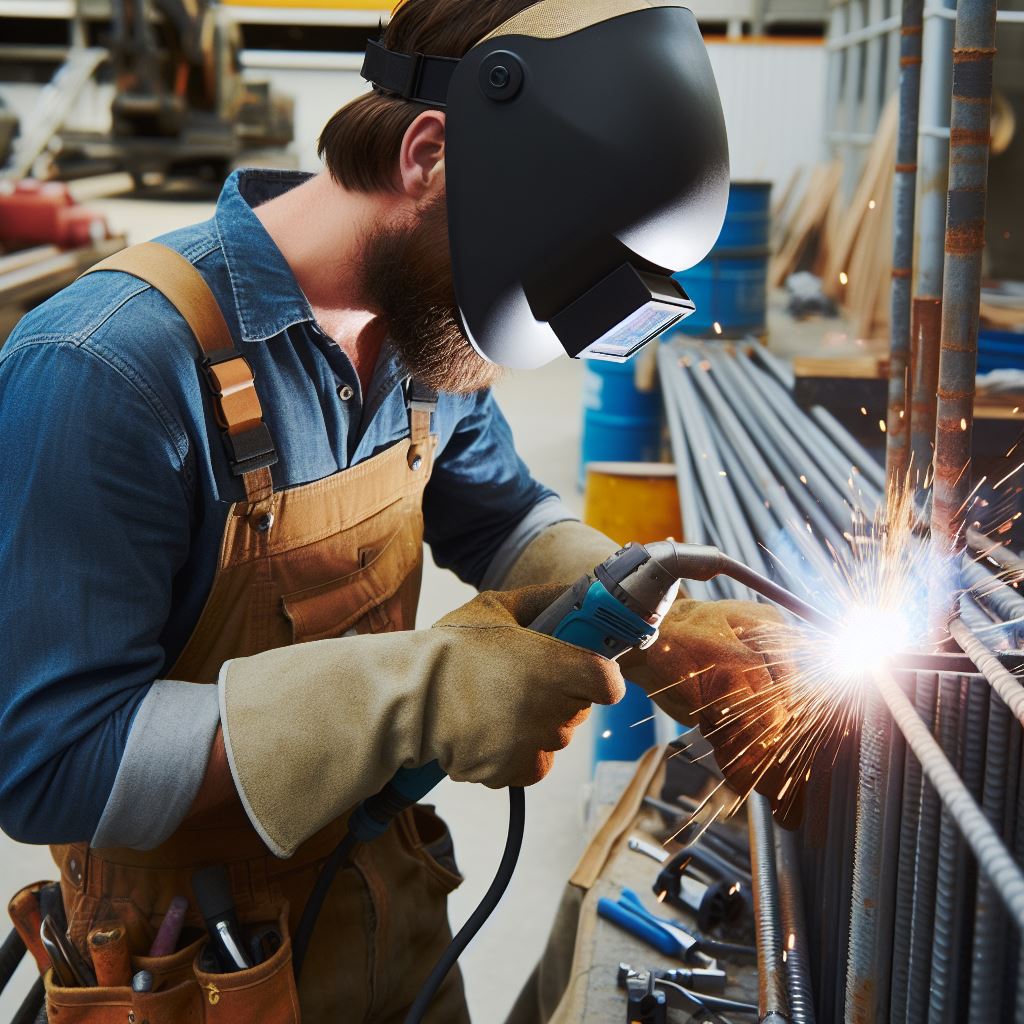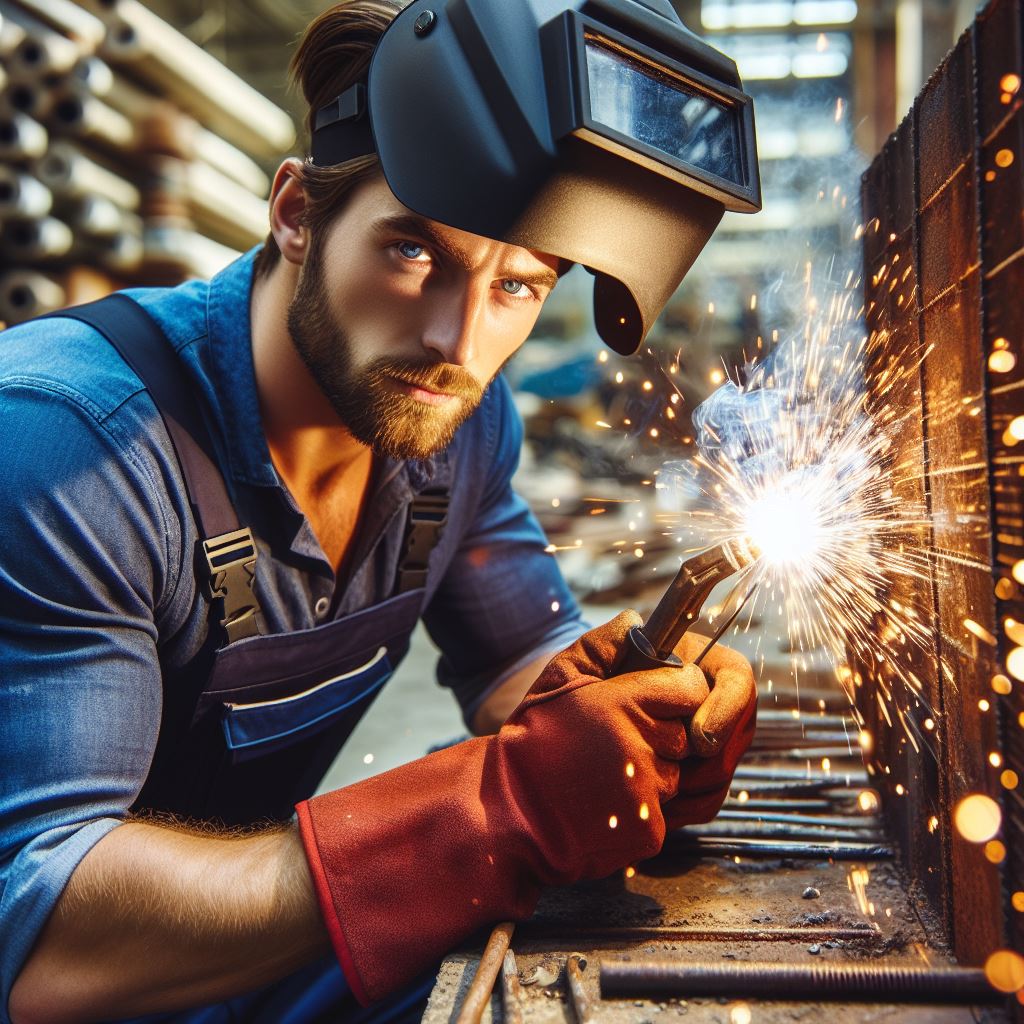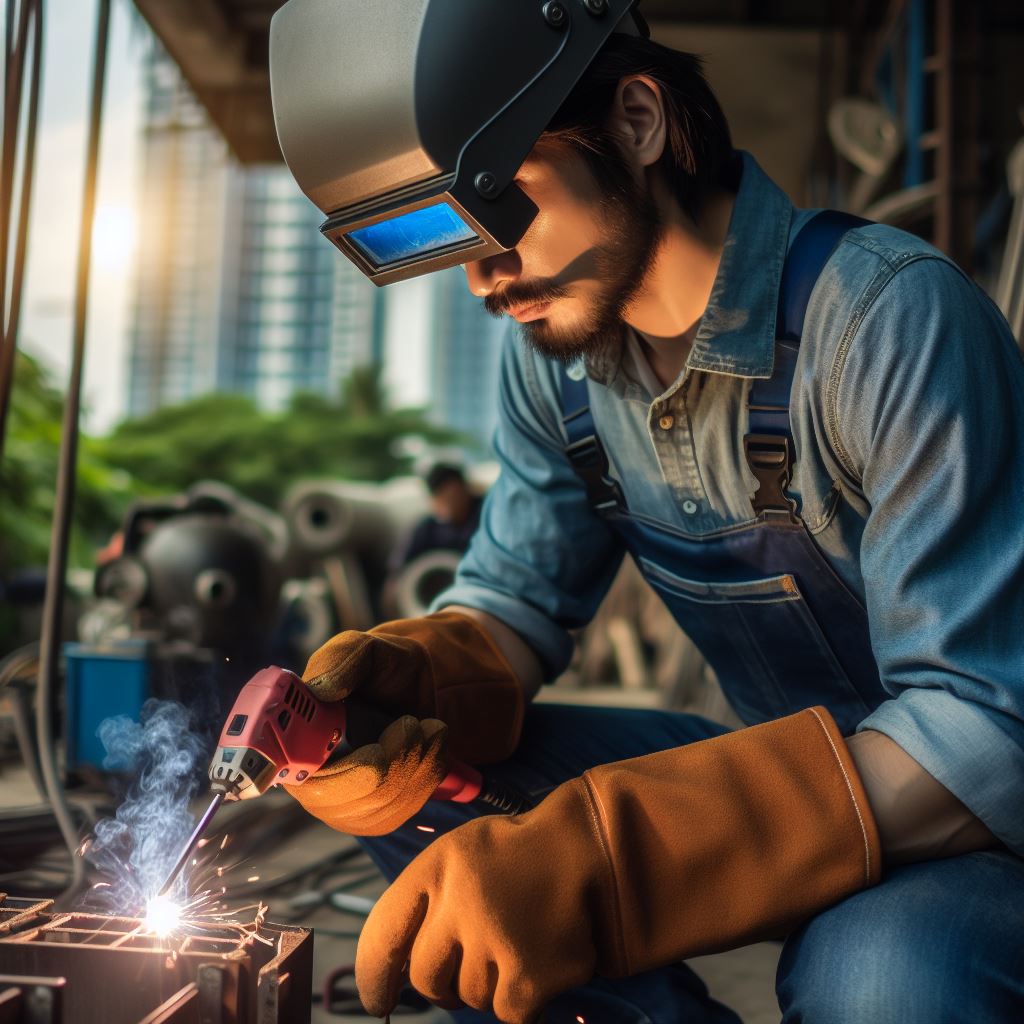Introduction
A career in welding offers a wide range of opportunities for individuals interested in working with metal. With the growing importance and demand for welding in Australia, this guide aims to provide a complete overview of the field.
Welding is a versatile career choice that plays a significant role in various industries, including construction, manufacturing, and automotive. In Australia, the demand for skilled welders is on the rise due to ongoing infrastructure projects and industrial growth.
This guide seeks to cover every aspect of welding careers in Australia, from the required skills and education to the potential job prospects and salary expectations.
It aims to serve as a comprehensive resource for students, job seekers, and anyone interested in pursuing a career in welding.
Throughout this guide, readers can expect to gain insights into different welding techniques, necessary certifications, and training programs available in Australia.
It will also explore the specific industries that often require welding expertise, highlighting job opportunities and the skills required to succeed in each sector.
Whether you are a novice welder looking to kickstart your career or an experienced professional seeking growth opportunities, this guide will provide valuable information and resources to help you navigate the welding industry in Australia.
By the end of this guide, readers will have a clear understanding of the welding profession and the steps required to embark on a successful welding career journey.
Types of Welding Careers
Introduction to different types of welding
- MIG welding: The most common type of welding that uses a wire electrode to join metals.
- TIG welding: A precise and clean process that uses a tungsten electrode and filler metal.
- Arc welding: Uses an electric arc between an electrode and the metal being welded.
- Oxyacetylene welding: This method uses a mixture of oxygen and acetylene to produce a flame for welding.
- Underwater welding: Highly specialized and performed underwater, utilizing special equipment and techniques.
Description and job prospects of each type
- MIG welding: Involves operating a MIG welding machine to join various types of metals. Job prospects are generally high due to the demand in manufacturing, construction, and automotive industries.
- TIG welding: Offers precise control and is commonly used for projects requiring a high level of quality, such as aerospace and automotive industries. Job prospects are good for skilled TIG welders.
- Arc welding: A versatile method used in various industries, including construction, maintenance, and fabrication. Job prospects vary depending on specialization and industry demand.
- Oxyacetylene welding: Commonly used for cutting, brazing, and welding small repairs. Job prospects may be limited due to advancements in other welding techniques.
- Underwater welding: Extremely specialized and requires additional certifications. Job prospects can be limited but offer high earning potential.
Comparison of skills required and potential income for each type
| Welding Type | Skills Required | Potential Income |
|---|---|---|
| MIG welding | Proficiency in operating MIG machines and knowledge of different metals. | Average income of AUD 55,000 to AUD 75,000 per year. |
| TIG welding | Excellent hand-eye coordination, attention to detail, and ability to weld thin materials. | Average income of AUD 60,000 to AUD 80,000 per year. |
| Arc welding | Knowledge of various welding techniques, ability to read blueprints, and physical strength. | Income can vary from AUD 50,000 to AUD 80,000 per year depending on specialization. |
| Oxyacetylene welding | Ability to manipulate the flame, understand materials, and problem-solving skills. | Income can range from AUD 40,000 to AUD 65,000 per year. |
| Underwater welding | Advanced diving skills, strong welding abilities, and knowledge of underwater conditions. | Significant earning potential with incomes surpassing AUD 100,000 per year. |
Overall, there are several types of welding careers in Australia, each with its own unique requirements and potential income.
It is crucial for individuals to choose the type of welding that aligns with their skills and interests to secure a successful and rewarding career.
Education and Training
Formal education options
- Vocational training programs provide hands-on experience for aspiring welders.
- TAFE courses offer specialized training and qualifications in welding.
- Apprenticeships combine on-the-job training with classroom instruction, leading to a trade qualification.
Necessary certifications and licenses
- Welding certification levels determine a welder’s skill and competency in specific welding processes.
- Occupational Health and Safety requirements ensure a safe working environment for welders.
- Codes and standards govern the quality and integrity of welded structures.
Importance of continuous training and staying updated with industry advancements
Welding is an ever-evolving field, and it is crucial for welders to stay updated with industry advancements.
Continuous training allows welders to enhance their skills, learn new techniques, and adapt to changing technologies.
Advancements in welding technology, materials, and processes require welders to keep up with the latest developments.
By staying updated, welders can remain competitive in the job market and ensure high-quality workmanship.
Regular training also helps welders improve their knowledge of safety protocols and adhere to industry standards.
Employers value welders who are committed to continuous learning and are knowledgeable about the latest techniques.
Attending workshops, seminars, and industry conferences can provide valuable networking opportunities for welders.
Additionally, certifications and qualifications obtained through continuing education can boost career prospects and earning potential.
Continuous training demonstrates a welder’s dedication to professional growth and their commitment to excellence in their craft.
Your Personalized Career Strategy
Unlock your potential with tailored career consulting. Get clear, actionable steps designed for your success. Start now!
Get StartedIn short, education and training play a vital role in welding careers in Australia. From vocational training programs to TAFE courses and apprenticeships, there are various formal education options available for aspiring welders.
Obtaining necessary certifications and licenses, such as welding certification levels and adhering to Occupational Health and Safety requirements, is essential for being a competent and safe welder.
Moreover, continuous training and staying updated with industry advancements are crucial to remain competitive, improve skills, and ensure high-quality workmanship.
Welders who invest in their education and professional development are more likely to thrive in their careers and achieve success in the dynamic field of welding.
Job Opportunities and Growth
Overview of current job market for welders in Australia
The job market for welders in Australia is currently thriving, with numerous job opportunities available. Skilled welders are in high demand, and there is a shortage of qualified professionals in this field.
Industries that heavily rely on welding
Construction
The construction industry heavily relies on welding for various projects, including the assembly and installation of structural components, bridges, and infrastructure.
Manufacturing
Welding plays a crucial role in the manufacturing industry, ranging from fabricating small parts to constructing large machinery and equipment.
Engineering
In the field of engineering, welding is essential for building and maintaining structures, pipelines, and pressure vessels, ensuring their integrity and durability.
Automotive
The automotive industry relies on welding for the production and repair of vehicles, including the assembly of frames, body components, and exhaust systems.
Shipbuilding
Welding is vital in the shipbuilding industry for joining hulls, installing pipelines and electrical systems, and assembling various parts and components.
Potential career paths and advancement opportunities within welding
Welding Inspector
Experienced welders can pursue a career as a welding inspector, responsible for inspecting welds for quality assurance and ensuring compliance with industry standards.
Welding Supervisor
Welders can transition into a supervisory role, overseeing a team of welders, managing projects, and ensuring adherence to safety guidelines and project specifications.
Welding Engineer
With further education and training, welders can become welding engineers, involved in designing welding processes, developing welding procedures, and conducting research in welding technology.
Welding Educator
Experienced welders can choose to share their knowledge and skills by becoming welding educators, training future generations of welders and staying connected to the industry.
Entrepreneurship
Highly skilled welders have the opportunity to start their own welding business, providing welding services, fabricating custom products, or specializing in a niche welding field.
Advancement within the welding field can also come in the form of obtaining specialized certifications, such as Certified Welding Inspector (CWI), Certified Welding Supervisor (CWS), or Certified Welding Engineer (CWE).
These certifications enhance career prospects and open doors to higher-paying positions.
Overall, the job market for welders in Australia is promising, with a range of industries heavily relying on welding.
This demand creates various career paths and advancement opportunities for skilled welders, allowing them to carve a successful and financially rewarding career in the field of welding.
Stand Out with a Resume That Gets Results
Your career is worth more than a generic template. Let us craft a resume and cover letter that showcase your unique strengths and help you secure that dream job.
Get HiredWork Environment and Conditions
Typical work settings for welders
- Welders often work in workshop-based environments.
- They can also be found working on construction sites.
- Some welders work offshore or underwater, such as in oil and gas industries.
Physical demands and safety precautions
- Welders must wear protective equipment to ensure their safety.
- There are health risks associated with welding, so prevention techniques are essential.
Work-life balance and potential travel requirements
Welders may experience challenges in maintaining a work-life balance due to the nature of their profession.
Some welding jobs, especially in construction and offshore industries, may require travel.
Read: How to Become a Plumber in Australia

Salary and Benefits
Average salary range for welders in Australia
- The average salary range for welders in Australia varies depending on several factors.
- However, the median annual salary is approximately $60,000 to $70,000.
Factors influencing salary variances
- Experience and skill level play a significant role in determining a welder’s salary.
- Welders with years of experience and advanced skills tend to earn higher salaries.
- Location also influences salary variances, with welders in metropolitan areas earning more than those in regional areas.
- The demand for welders in specific regions can also impact salary levels.
- The industry specialization of a welder can affect their earning potential.
- Welders in high-demand industries such as mining and construction often command higher salaries.
- On the other hand, welders in industries with lower demand may receive lower salaries.
Additional benefits and perks commonly associated with welding careers
- Welders in Australia often receive additional benefits and perks, enhancing their overall compensation packages.
- Health insurance coverage is a common benefit provided by many employers.
- Retirement plans, such as superannuation funds, are also offered to welders.
- Some employers may provide bonuses or profit-sharing programs based on performance.
- Paid time off, including holidays and vacation days, is another valuable benefit for welders.
- Opportunities for career advancement and professional development are often available.
- Employers may sponsor additional training or certifications to help welders enhance their skills.
- Flexible work schedules or shift differentials may be provided, particularly in industries with round-the-clock operations.
- Job security is another advantage, as welding skills are consistently in demand across various industries.
- Some employers offer relocation assistance or housing allowances for welders who need to move for employment.
In summary, welding careers in Australia offer competitive salary ranges, influenced by factors such as experience, location, and industry specialization.
Welders can expect additional benefits and perks, including health insurance, retirement plans, and opportunities for professional growth.
With job security and various incentives, welding remains a promising career choice with attractive compensation packages.
Read: A Day in the Life of an Aussie Plumber
See Related Content: Latest Carpentry Tech Trends in Australia
Challenges and Rewards
Common challenges faced by welders
- Welding poses significant physical demands on the body, resulting in fatigue and potential injuries.
- Worksite hazards such as exposure to fumes, gases, and high temperatures are common in welding careers.
- Job insecurity can be a challenge, as welders may face periods of unemployment or short-term projects.
Intrinsic rewards of welding careers
- Welding allows for creativity and craftsmanship, as welders have the opportunity to shape and create intricate structures.
- Problem-solving is a key aspect of welding, providing job satisfaction as welders overcome technical challenges.
- Welding offers job stability, as skilled welders are in high demand across various industries.
- Growth potential exists in welding careers, with opportunities for specialization and advancement into supervisory or managerial roles.
Welding, like any other profession, presents both challenges and rewards. Understanding and being prepared for the challenges can help welders thrive in their careers.
Challenges in Welding: Physical Strain and Worksite Hazards
A common challenge faced by welders is the physical demands of the job. The nature of welding requires repetitive motion, often in uncomfortable positions, leading to physical fatigue.
Additionally, the use of heavy equipment and tools can put strain on the body, increasing the risk of injuries.
Worksite hazards are another challenge for welders. Exposure to fumes, gases, and high temperatures can lead to respiratory problems, eye injuries, and burns.
Welders must be vigilant about wearing appropriate personal protective equipment and following safety protocols to mitigate these hazards.
Navigating Challenges and Unleashing Creativity: The Dynamic World of Welding Careers
Job insecurity is a challenge that welders may face. The availability of welding projects can fluctuate, leading to periods of unemployment or short-term contracts.
This uncertainty requires welders to be adaptable and open to seeking opportunities in different industries or locations.
Despite these challenges, welding careers offer intrinsic rewards that can make the profession fulfilling. One of the rewards of welding is the opportunity to unleash creativity and showcase craftsmanship.
Welders have the ability to transform raw materials into intricate structures, making each project a unique piece of art.
Fulfilling Rewards and Stability in Welding Careers
Problem-solving is an essential skill in welding and provides job satisfaction for welders. Overcoming technical challenges and finding innovative solutions to welding problems can be intellectually stimulating and rewarding.
Job stability is another intrinsic reward of welding careers. Skilled welders are in high demand across various industries such as construction, manufacturing, and automotive. With the constant need for welding expertise, welders can enjoy stable employment and job security.
Balancing Challenges and Rewards: The Dynamic Landscape of Welding Careers
Furthermore, welding careers offer growth potential. Welders have opportunities to specialize in specific welding techniques or pursue advanced certifications, opening doors to higher-paying positions.
With experience and additional training, welders can advance into supervisory or managerial roles, expanding their responsibilities and earning potential.
Transform Your LinkedIn for Maximum Impact
Elevate your professional brand with a LinkedIn profile that attracts recruiters, showcases your expertise, and maximizes opportunities. Stand out in your industry with a profile built for success.
Boost ProfileIn essence, welding careers come with both challenges and rewards. By recognizing and proactively addressing challenges such as physical demands, worksite hazards, and job insecurity, welders can navigate the profession successfully.
Intrinsic rewards like creativity, problem-solving, job stability, and growth potential make welding a fulfilling and satisfying career choice.
Read: The Future of Plumbing Tech in Australia
Delve into the Subject: Energy-Efficient Building in Australia Today
Uncover the Details: Innovative Building Materials in Australia
Conclusion
Recap of key points covered in the guide
In this comprehensive guide, we explored the various aspects of welding careers in Australia.
We discussed the high demand for skilled welders, job prospects, and salary potential.
We also highlighted the different types of welding disciplines and the necessary qualifications and certifications.
Encouragement for individuals considering a welding career in Australia
If you are passionate about working with metal and have a keen eye for detail, a welding career in Australia can be highly rewarding.
With the growing need for skilled welders across various industries, there are ample opportunities for career growth and development.
By acquiring the right skills and certifications, you can embark on a fulfilling and financially stable career in welding.
Resources and next steps for further exploration
To further explore welding careers in Australia, we recommend checking out industry-specific magazines and websites.
Additionally, vocational training institutions and trade organizations offer courses and apprenticeships to help you kickstart your welding career.
Don’t forget to network with professionals in the field and attend industry trade shows and events to stay updated on the latest advancements.
By staying informed and honing your skills, you can unlock a world of opportunities in the exciting field of welding in Australia.
So, take the leap and embark on an enriching journey as a skilled welder in the land down under!




